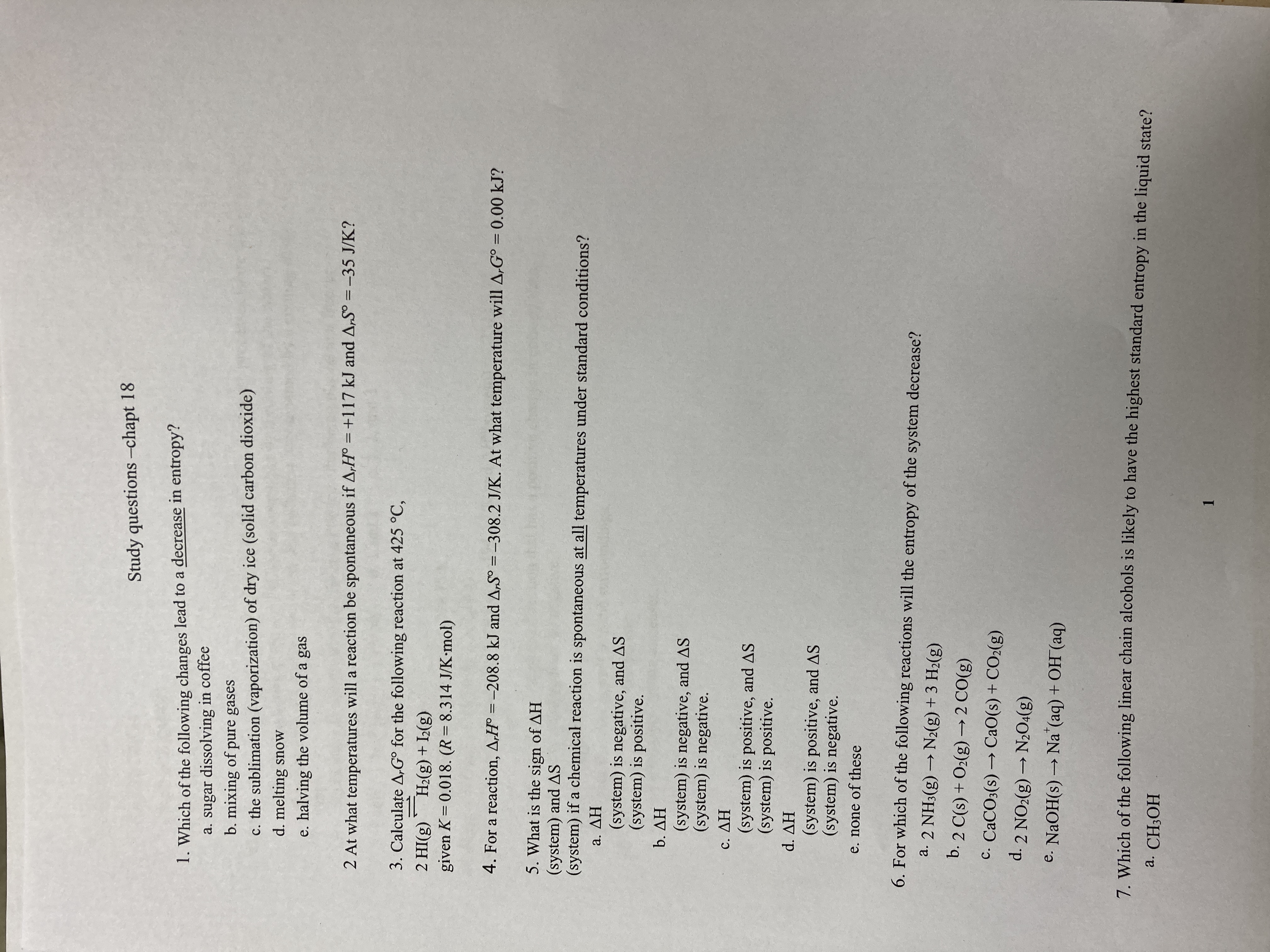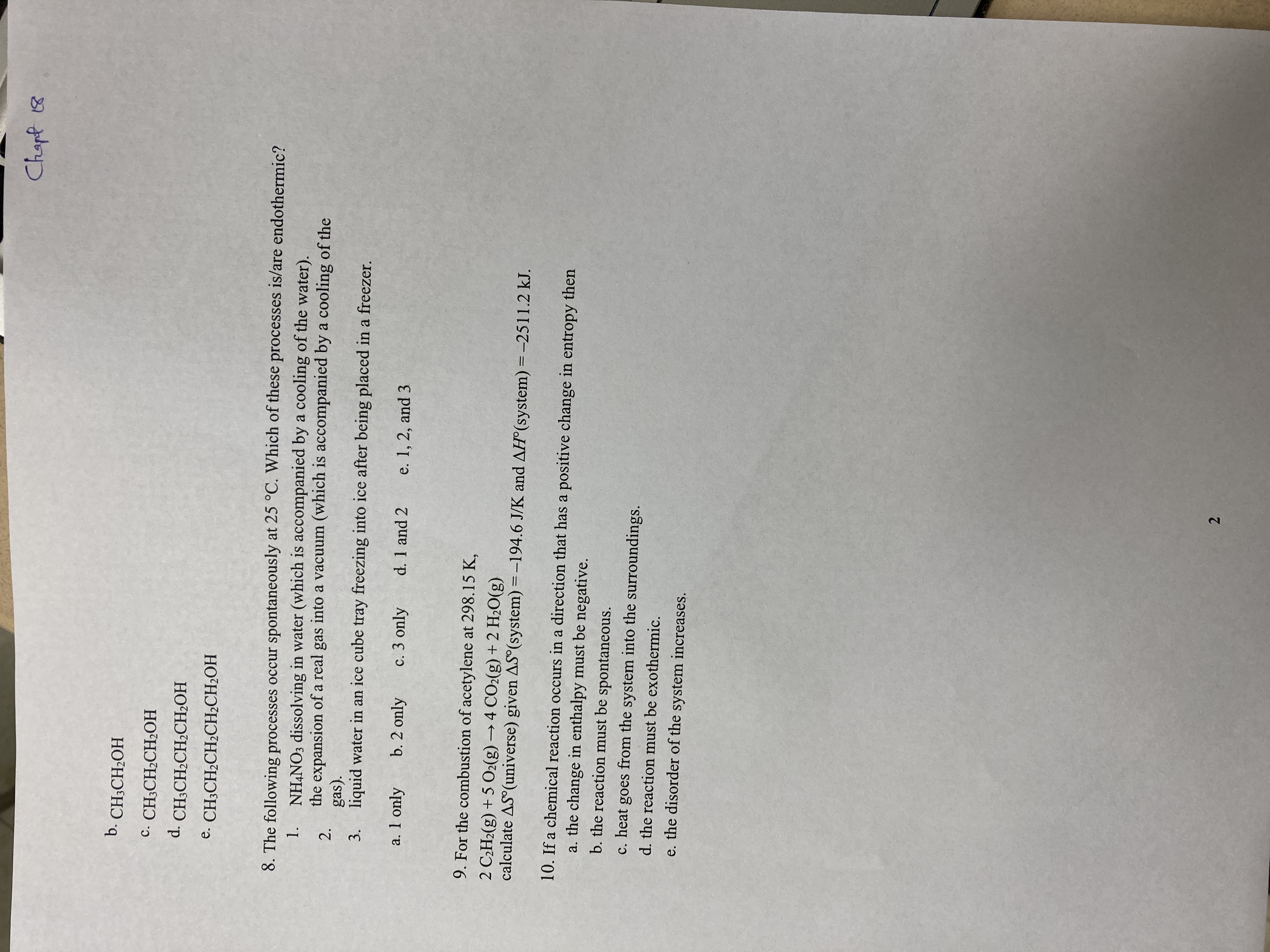
Chemistry
10th Edition
ISBN: 9781305957404
Author: Steven S. Zumdahl, Susan A. Zumdahl, Donald J. DeCoste
Publisher: Cengage Learning
expand_more
expand_more
format_list_bulleted
Question

Transcribed Image Text:Study questions -chapt 18
1. Which of the following changes lead to a decrease in entropy?
a. sugar dissolving in coffee
b. mixing of pure gases
c. the sublimation (vaporization) of dry ice (solid carbon dioxide)
d. melting snow
e. halving the volume of a gas
2 At what temperatures will a reaction be spontaneous if A,H° = +117 kJ and A,S° =-35 J/K?
3. Calculate A,G° for the following reaction at 425 °C,
(8)I + (3)*H_, (3)IH
given K= 0.018. (R=8.314 J/K-mol)
%3D
4. For a reaction, A,H° = -208.8 kJ and A,S° =-308.2 J/K. At what temperature will A,G° = 0.00 kJ?
%3D
%3D
5. What is the sign of AH
(system) and AS
(system) if a chemical reaction is spontaneous at all temperatures under standard conditions?
HV ε
(system) is negative, and AS
(system) is positive.
HV °q
(system) is negative, and AS
(system) is negative.
HV
(system) is positive, and AS
(system) is positive.
HV P
(system) is positive, and AS
(system) is negative.
e. none of these
6. For which of the following reactions will the entropy of the system decrease?
a. 2 NH3(g) → N2(g) + 3 H2(g)
b. 2 C(s) + O2(g) → 2 CO(g)
C. CACO3(s) → CaO(s) + CO2(g)
d. 2 NO2(g) → N20:(g)
e. NaOH(s) → Na (aq) + OH (aq)
7. Which of the following linear chain alcohols is likely to have the highest standard entropy in the liquid state?
a. CH;OH
1.

Transcribed Image Text:2.
Chapt 18
b. CH;CH2OH
с. CH-CH.CH-OН
d. CH;CH2CH2CH2OH
e. CH3CH2CH2CH2CH2OH
8. The following processes occur spontaneously at 25 °C. Which of these processes is/are endothermic?
NH,NO3 dissolving in water (which is accompanied by a cooling of the water).
the expansion of a real gas into a vacuum (which is accompanied by a cooling of the
1.
2.
gas).
3. liquid water in an ice cube tray freezing into ice after being placed in a freezer.
a. 1 only
b. 2 only
c. 3 only
d. 1 and 2
e. 1, 2, and 3
9. For the combustion of acetylene at 298.15 K,
2 C¿H2(g) + 5 O2(g) → 4 CO2(g) + 2 H2O(g)
calculate AS (universe) given AS (system) = -194.6 J/K and AH°(system) = -2511.2 kJ.
10. If a chemical reaction occurs in a direction that has a positive change in entropy then
a. the change in enthalpy must be negative.
b. the reaction must be spontaneous.
c. heat goes from the system into the surroundings.
d. the reaction must be exothermic.
e. the disorder of the system increases.
Expert Solution
This question has been solved!
Explore an expertly crafted, step-by-step solution for a thorough understanding of key concepts.
This is a popular solution
Trending nowThis is a popular solution!
Step by stepSolved in 2 steps

Knowledge Booster
Learn more about
Need a deep-dive on the concept behind this application? Look no further. Learn more about this topic, chemistry and related others by exploring similar questions and additional content below.Similar questions
- 8 As you dissolve salt in water, what change would you expect to occur? A B C D The entropy of the system will increase. The kinetic energy of the water molecules decreases. The salt consumes energy as it transfers entropy The water molecules become more closely packed as the temperature increasesarrow_forwardCompare what will happen to the entropy of the whole system in the following two scenarios: A) if the oil molecules are all clumped together and the clump is surrounded by water and B) if the oil molecules are spread out evenly throughout the water, each individual oil molecule surrounded by water?arrow_forwardIn which of the following processes would the entropy of the system increase? A liquid forming from a gas. A solid forming from a gas. The number of gas molecules increasing during a chemical reaction. A solid precipitating from a solution.arrow_forward
Recommended textbooks for you
 ChemistryChemistryISBN:9781305957404Author:Steven S. Zumdahl, Susan A. Zumdahl, Donald J. DeCostePublisher:Cengage Learning
ChemistryChemistryISBN:9781305957404Author:Steven S. Zumdahl, Susan A. Zumdahl, Donald J. DeCostePublisher:Cengage Learning ChemistryChemistryISBN:9781259911156Author:Raymond Chang Dr., Jason Overby ProfessorPublisher:McGraw-Hill Education
ChemistryChemistryISBN:9781259911156Author:Raymond Chang Dr., Jason Overby ProfessorPublisher:McGraw-Hill Education Principles of Instrumental AnalysisChemistryISBN:9781305577213Author:Douglas A. Skoog, F. James Holler, Stanley R. CrouchPublisher:Cengage Learning
Principles of Instrumental AnalysisChemistryISBN:9781305577213Author:Douglas A. Skoog, F. James Holler, Stanley R. CrouchPublisher:Cengage Learning Organic ChemistryChemistryISBN:9780078021558Author:Janice Gorzynski Smith Dr.Publisher:McGraw-Hill Education
Organic ChemistryChemistryISBN:9780078021558Author:Janice Gorzynski Smith Dr.Publisher:McGraw-Hill Education Chemistry: Principles and ReactionsChemistryISBN:9781305079373Author:William L. Masterton, Cecile N. HurleyPublisher:Cengage Learning
Chemistry: Principles and ReactionsChemistryISBN:9781305079373Author:William L. Masterton, Cecile N. HurleyPublisher:Cengage Learning Elementary Principles of Chemical Processes, Bind...ChemistryISBN:9781118431221Author:Richard M. Felder, Ronald W. Rousseau, Lisa G. BullardPublisher:WILEY
Elementary Principles of Chemical Processes, Bind...ChemistryISBN:9781118431221Author:Richard M. Felder, Ronald W. Rousseau, Lisa G. BullardPublisher:WILEY

Chemistry
Chemistry
ISBN:9781305957404
Author:Steven S. Zumdahl, Susan A. Zumdahl, Donald J. DeCoste
Publisher:Cengage Learning

Chemistry
Chemistry
ISBN:9781259911156
Author:Raymond Chang Dr., Jason Overby Professor
Publisher:McGraw-Hill Education

Principles of Instrumental Analysis
Chemistry
ISBN:9781305577213
Author:Douglas A. Skoog, F. James Holler, Stanley R. Crouch
Publisher:Cengage Learning

Organic Chemistry
Chemistry
ISBN:9780078021558
Author:Janice Gorzynski Smith Dr.
Publisher:McGraw-Hill Education

Chemistry: Principles and Reactions
Chemistry
ISBN:9781305079373
Author:William L. Masterton, Cecile N. Hurley
Publisher:Cengage Learning

Elementary Principles of Chemical Processes, Bind...
Chemistry
ISBN:9781118431221
Author:Richard M. Felder, Ronald W. Rousseau, Lisa G. Bullard
Publisher:WILEY